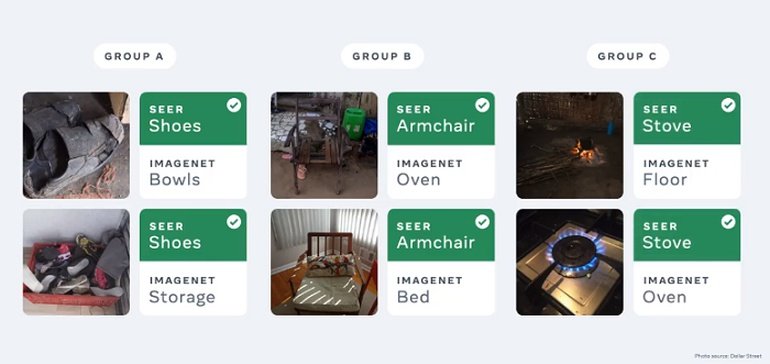SOCIAL
Meta Shares its Latest Advances in Automated Object Identification, a Key Development in its AR Push

Meta has outlined its latest advances in automated object identification within images, with its updated SEER system now, according to Meta, the largest and most advanced computer vision model available.
SEER – which is a derivative of ‘self-supervised’ – is able to learn from any random group of images on the internet, without the need for manual curation and labeling, which accelerates its capacity to identify a wide array of different objects within a frame, and it’s now able to outperform the leading industry standard computer vision systems in terms of accuracy.
And it’s only getting better. The original version of SEER, which was initially announced by Meta last year, was built on a model of over 1 billion images. This new version is now 10x the scope.
As explained by Meta:
“When we first announced SEER last spring, it outperformed state-of-the-art systems, demonstrating that self-supervised learning can excel at computer vision tasks in real world settings. We’ve now scaled SEER from 1 billion to 10 billion dense parameters, making it to our knowledge the largest dense computer vision model of its kind.”
Of particular note is the system’s capacity to identify different images of different people and cultures, while it’s also able to assign meaning and interpretation to objects from varying global regions.
“Traditional computer vision systems are trained primarily on examples from the U.S. and wealthy countries in Europe, so they often don’t work well for images from other places with different socioeconomic characteristics. But SEER delivers strong results for images from all around the globe – including non-U.S. and non-Europe regions with a wide range of income levels.”
That’s significant, because it’ll expand the system’s understanding of different objects and uses, which can then help to improve accuracy, and provide better automated descriptions of what’s in a frame. That can then provide more context for visually impaired users, along with product identification matching, signage signals, branding alerts, etc.
Meta also notes that the system is a key component of its next shift.
“Advancing computer vision is an important part of building the Metaverse. For example, to build AR glasses that can guide you to your misplaced keys or show you how to make a favorite recipe, we will need machines that understand the visual world as people do. They will need to work well in kitchens not just in Kansas and Kyoto but also in Kuala Lumpur, Kinshasa, and myriad other places around the world. This means recognizing all the different variations of everyday objects like house keys or stoves or spices. SEER breaks new ground in achieving this robust performance.”
Meta’s been working on improved object identification for years, and has made significant advances in terms of automated captions, reader descriptions and more.

It’s also working on identifying objects within video, the next stage. And while that’s not a viable option as yet, it could, eventually, lead to all new data insights, by enabling you to learn more about what each individual user posts about, and how to reach them with your promotions.
Even right now, this can be valuable. If you knew, for example, that a certain subset of users on Instagram were more likely to post a picture of their meal, based on previous posting patterns, that could help in your ad targeting. Extrapolate that to any subject, with a high degree of accuracy in data matching, and that could be a great way to generate maximum value from your ad approach.
And that’s before, as Meta notes, considering the advanced applications in AR overlays, or in improving its video algorithms to show people more of the content they’re more likely to engage with, based on what’s actually in each frame.
The next stage is coming, and systems like this will underpin major shifts in online connectivity.
You can read more about Meta’s SEER system here.
Source link
SOCIAL
Snapchat Explores New Messaging Retention Feature: A Game-Changer or Risky Move?

In a recent announcement, Snapchat revealed a groundbreaking update that challenges its traditional design ethos. The platform is experimenting with an option that allows users to defy the 24-hour auto-delete rule, a feature synonymous with Snapchat’s ephemeral messaging model.
The proposed change aims to introduce a “Never delete” option in messaging retention settings, aligning Snapchat more closely with conventional messaging apps. While this move may blur Snapchat’s distinctive selling point, Snap appears convinced of its necessity.
According to Snap, the decision stems from user feedback and a commitment to innovation based on user needs. The company aims to provide greater flexibility and control over conversations, catering to the preferences of its community.
Currently undergoing trials in select markets, the new feature empowers users to adjust retention settings on a conversation-by-conversation basis. Flexibility remains paramount, with participants able to modify settings within chats and receive in-chat notifications to ensure transparency.
Snapchat underscores that the default auto-delete feature will persist, reinforcing its design philosophy centered on ephemerality. However, with the app gaining traction as a primary messaging platform, the option offers users a means to preserve longer chat histories.
The update marks a pivotal moment for Snapchat, renowned for its disappearing message premise, especially popular among younger demographics. Retaining this focus has been pivotal to Snapchat’s identity, but the shift suggests a broader strategy aimed at diversifying its user base.
This strategy may appeal particularly to older demographics, potentially extending Snapchat’s relevance as users age. By emulating features of conventional messaging platforms, Snapchat seeks to enhance its appeal and broaden its reach.
Yet, the introduction of message retention poses questions about Snapchat’s uniqueness. While addressing user demands, the risk of diluting Snapchat’s distinctiveness looms large.
As Snapchat ventures into uncharted territory, the outcome of this experiment remains uncertain. Will message retention propel Snapchat to new heights, or will it compromise the platform’s uniqueness?
Only time will tell.
SOCIAL
Catering to specific audience boosts your business, says accountant turned coach

While it is tempting to try to appeal to a broad audience, the founder of alcohol-free coaching service Just the Tonic, Sandra Parker, believes the best thing you can do for your business is focus on your niche. Here’s how she did just that.
When running a business, reaching out to as many clients as possible can be tempting. But it also risks making your marketing “too generic,” warns Sandra Parker, the founder of Just The Tonic Coaching.
“From the very start of my business, I knew exactly who I could help and who I couldn’t,” Parker told My Biggest Lessons.
Parker struggled with alcohol dependence as a young professional. Today, her business targets high-achieving individuals who face challenges similar to those she had early in her career.
“I understand their frustrations, I understand their fears, and I understand their coping mechanisms and the stories they’re telling themselves,” Parker said. “Because of that, I’m able to market very effectively, to speak in a language that they understand, and am able to reach them.”Â
“I believe that it’s really important that you know exactly who your customer or your client is, and you target them, and you resist the temptation to make your marketing too generic to try and reach everyone,” she explained.
“If you speak specifically to your target clients, you will reach them, and I believe that’s the way that you’re going to be more successful.
Watch the video for more of Sandra Parker’s biggest lessons.
SOCIAL
Instagram Tests Live-Stream Games to Enhance Engagement

Instagram’s testing out some new options to help spice up your live-streams in the app, with some live broadcasters now able to select a game that they can play with viewers in-stream.
As you can see in these example screens, posted by Ahmed Ghanem, some creators now have the option to play either “This or That”, a question and answer prompt that you can share with your viewers, or “Trivia”, to generate more engagement within your IG live-streams.
That could be a simple way to spark more conversation and interaction, which could then lead into further engagement opportunities from your live audience.
Meta’s been exploring more ways to make live-streaming a bigger consideration for IG creators, with a view to live-streams potentially catching on with more users.
That includes the gradual expansion of its “Stars” live-stream donation program, giving more creators in more regions a means to accept donations from live-stream viewers, while back in December, Instagram also added some new options to make it easier to go live using third-party tools via desktop PCs.
Live streaming has been a major shift in China, where shopping live-streams, in particular, have led to massive opportunities for streaming platforms. They haven’t caught on in the same way in Western regions, but as TikTok and YouTube look to push live-stream adoption, there is still a chance that they will become a much bigger element in future.
Which is why IG is also trying to stay in touch, and add more ways for its creators to engage via streams. Live-stream games is another element within this, which could make this a better community-building, and potentially sales-driving option.
We’ve asked Instagram for more information on this test, and we’ll update this post if/when we hear back.
-

 PPC5 days ago
PPC5 days ago19 Best SEO Tools in 2024 (For Every Use Case)
-

 MARKETING6 days ago
MARKETING6 days agoStreamlining Processes for Increased Efficiency and Results
-
SEARCHENGINES6 days ago
Daily Search Forum Recap: April 17, 2024
-

 SEO6 days ago
SEO6 days agoAn In-Depth Guide And Best Practices For Mobile SEO
-

 PPC6 days ago
PPC6 days ago97 Marvelous May Content Ideas for Blog Posts, Videos, & More
-
SEARCHENGINES5 days ago
Daily Search Forum Recap: April 18, 2024
-

 MARKETING6 days ago
MARKETING6 days agoEcommerce evolution: Blurring the lines between B2B and B2C
-
SEARCHENGINES4 days ago
Daily Search Forum Recap: April 19, 2024














You must be logged in to post a comment Login